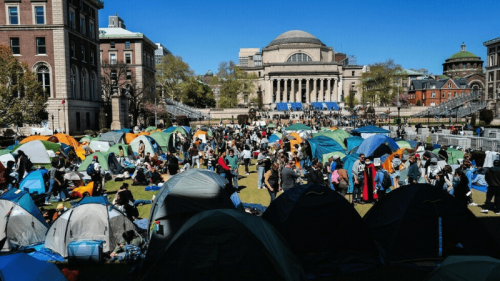THE particular footnote authored by two dissenting judges in the matter of delayed polls doesn’t seem like it will be forgotten anytime soon.
Indeed, the government’s team has built a raging debate on top of it, claiming that the Supreme Court’s ruling was a 4-3 majority decision in its favour, and not a 3-2 verdict against.
However, most legal experts Dawn spoke to have suggested that the government was probably reading too much between the lines, and the dissenting views should not be linked to the present five-judge bench that conducted the hearing afresh.
The much-anticipated Supreme Court judgement on poll delay in Punjab and Khyber Pakhtunkhwa after the assemblies’ dissolution sparked more questions soon after its announcement.
The footnote in question, written by Justice Syed Mansoor Ali Shah and Justice Jamal Khan Mandokhail, added fuel to the fire with all kinds of speculation and disagreements making rounds.
It recalled how initially a nine-judge bench heard the matter, but Justice Yayha Afridi and Justice Athar Minallah, in their additional notes, dismissed petitions moved by former speakers of KP and Punjab.
Later, two judges — Justice Ijazul Ahsan and Justice Sayyed Mazahar Ali Naqvi — disassociated themselves from the bench for personal reasons and since the earlier judges had dismissed the matter, the bench was reconstituted into a five-judge bench through the Feb 27 order, the footnote said, adding that the decisions or additional note of the two judges of Feb 23 form part of the record of this case.
The controversy further got hyped when Law Minister Azam Nazeer Tarar along with Attorney General for Pakistan (AGP) Shehzad Ata Elahi in a presser explained that there was no need to move any review petition before the Supreme Court nor was there a need of further interpretation since it was clear that the judgement was 4-3 and not 3-2.
Therefore, the majority judgement of four to three will prevail since similar cases on the same pleadings were pending before the Lahore High Court and the Peshawar High Court.
The law minister and the AGP also alleged that the president through Feb 20 fixing April 9 election dates in two provinces had committed a constitutional violation. “Is it the responsibility of the president to discharge his constitutional duties or allegedly behave like a party worker in the performance of his official duties?” they wondered.
Already Rs35 billion digital population census has kicked off in the country from Wednesday and it was a settled principle that the census should be done on the basis of population than the area and if the polls were held in Punjab and KP, then it would definitely have a bearing on holding general elections for the National Assembly, they said, adding that in case governments of a particular political party was installed in two provinces would take away the level playing field for other political parties.
Later, Interior Minister Rana Sanaullah told reporters in Islamabad that the federal government would accept the judgement as it was constitutionally binding, but in the same breath said the apex court’s 4-3 majority judgement had dismissed the election date suo moto case, describing it as premature.
Mr Sanaullah claimed that the court in its ruling held that the decision to take suo motu notice on the delay in polls of Punjab and KP assemblies was wrong as similar petitions were pending in the relevant high courts.
“The petition of PTI stands rejected and suo motu proceedings stand dropped in the light of the decision,” he said.
He said the matter was now before the high courts and any aggrieved party could approach the apex court to challenge the decision of such a court.
Meanwhile, the federal government on Wednesday decided not to file a review plea against the Supreme Court verdict regarding elections in Punjab and Khyber Pakhtunkhwa within 90 days.
Prime Minister Sharif held a meeting of PML-N leaders in which the party president decided not to challenge the court verdict. He also consulted party supremo Nawaz Sharif on the ruling.
‘Absurd, illogical, mischievous’
Most legal experts didn’t agree with the government’s point of view.
“This interpretation is a mischievous analysis,” a former advocate general for Punjab told Dawn.
A former additional attorney general, Tariq Mehmood Khokhar, was also in agreement in favour of the 3-2 judgement and said there were two different benches at two different points in time and any conflation of the two was “absurd and illogical”.
“A minority opinion of an earlier nine-member bench, assuming, against facts, that a judgement was delivered, cannot juridically be conflated with a minority opinion of a subsequent five-member bench, which actually delivered the judgement on Wednesday,” Mr Khokhar said, adding that since the premise was not correct, the conclusion drawn was plainly erroneous.
However, Advocate Umer Ijaz Gillani was of the view that it was not clear which judgement was the prevailing one: the one authored by Chief Justice of Pakistan (CJP) Umar Ata Bandial or the other one.
“It won’t be clear until a review is filed,” he suggested, adding that if and when a review was filed, the same issue would arise again whether it should be heard by all seven judges or only five.
“Therefore, for the first time in our history, a stalemate has been created which cannot be resolved — except, perhaps, through a full bench,” he said.
Former Punjab governor Rafique Rajwana said that being a political worker, he believed that political parties should not shy away of elections, but in this case, the political parties would be in a disadvantageous position if the government of a particular political party got installed in two provinces.
Senior counsel Hafiz Ahsaan Ahmed explained that there should be no legal confusion as the present judgement had been passed by a majority of 3:2 by the reconstituted five-judge bench.
Thus, the same has to be implemented as a majority judgement in letter and spirit by all the constitutional and state institutions, as four judges had earlier disassociated themselves after the first hearing of the nine-judge bench.
The views given by two judges in writing should not be linked with the present five-judge bench, which conducted the hearing afresh and resolved the present issue once and for all by clearly interpreting Article 224(2) of the Constitution that the elections should be held within 90 days for both Punjab and KP assemblies, he said.
Mr Ahmed explained that constituting the bench and fixing cases was the CJP’s prerogative under the Constitution and the Supreme Court Rules 1980, and the same could not be challenged.
Published in Dawn, March 2nd, 2023














































Dear visitor, the comments section is undergoing an overhaul and will return soon.